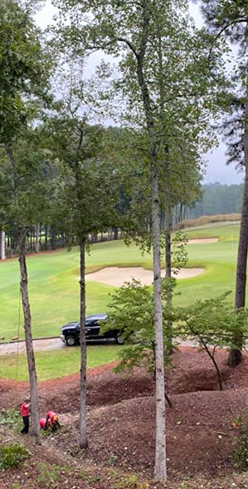Why Fall Is the Best Season for Tree Care
As summer winds down in Georgia, trees often carry stress from heat, drought, and storms. At the same time, cooler nights and shorter days signal the start of dormancy, making fall the perfect window for proactive tree care. By addressing tree health and structure now, you’re not only preparing for winter storms—you’re also setting the stage for strong spring growth.
Without proper fall care, trees face:
- Weak limbs that can snap under heavy rain or ice
- Pest and disease pressure carried into winter
- Soil deficiencies that reduce resilience next year
With a certified arborist’s guidance, fall becomes your opportunity to strengthen trees for the seasons ahead.
The Power of Structural Pruning
Structural tree pruning goes beyond basic trimming. It’s a science-backed practice that shapes a tree’s framework, ensuring stability against wind, rain, and ice while promoting long-term growth.
Benefits of structural pruning in fall include:
- Reducing breakage risk: Weak or crossing limbs are removed before storms strike.
- Improving canopy balance: A well-shaped crown reduces wind resistance.
- Supporting healthy growth: Dormant-season pruning promotes better recovery in spring.
At Arbor Equity, our team of certified experts applies the highest standards of arboriculture, making precise cuts that improve both safety and tree health.
Fall Plant Health Care (PHC) Evaluations
Tree strength isn’t just about structure—it’s also about overall vitality. That’s why a Plant Health Care (PHC) evaluation is essential in fall. This proactive approach ensures trees go into winter with the resources they need to thrive.
During a PHC evaluation, Arbor Equity’s arborists assess:
- Soil health and nutrition: Addressing compaction and nutrient needs
- Pest risks: Many insects overwinter in bark and soil, emerging strong in spring if untreated
- Disease prevention: Cooler, damp weather can foster fungal infections
Arbor Equity’s IPM Approach
Our PHC services are guided by Integrated Pest Management (IPM), which means we tailor treatments to your property and your trees’ needs. Rather than applying the same blanket solutions, we:
- Monitor your trees year-round
- Apply treatments only when necessary
- Use environmentally responsible methods
This ensures your trees stay healthy without unnecessary chemical use, balancing protection with sustainability.
Why Work with Certified Arborists?
Tree care isn’t just about removing branches. Certified arborists have the training to understand tree biology, diagnose hidden risks, and deliver solutions that extend a tree’s lifespan. With over 30 years of experience, Arbor Equity brings unmatched credentials and proven expertise to every property we service.
FAQ: Fall Tree Care in Georgia
When is the best time to prune trees in fall?
Early fall through late winter is ideal, when trees are entering dormancy. Pruning during this period reduces stress and encourages healthy regrowth in spring.
Do all trees need structural pruning?
Not every tree requires major pruning, but an arborist inspection can uncover weak or hazardous branches that may fail during storms.
What’s the difference between trimming and structural pruning?
Trimming is often cosmetic, while structural pruning focuses on shaping a stronger framework for long-term stability and safety.
How does a Plant Health Care (PHC) program help in fall?
PHC ensures your trees enter winter strong, addressing soil balance, pests, and diseases that could compromise health.
Is seasonal tree care worth the investment?
Absolutely. Preventive care in fall is far more cost-effective than emergency removals or property repairs after a storm.
Take Action Before the Season Shifts | Call Arbor Equity
Fall tree care is about more than just preparing for winter—it’s about building strength and resilience that carries into spring. With structural pruning and a tailored PHC plan, Arbor Equity helps your trees thrive through every season.
📞 Contact us today at 706-817-2094 to schedule your fall tree evaluation with a certified arborist.



